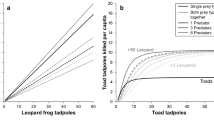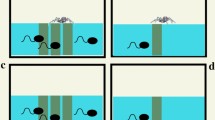Abstract
Interactions among and within three species of predators were estimated in terms of their effects on prey survival using short-term predation experiments. The prey were tadpoles (Rana temporaria), and the predators were dragonfly larvae (Anax imperator), newts (Triturus alpestris), and backswimmers (Notonecta glauca). Mortality rate per predator imposed by Triturus and Notonecta did not decline with predator density, whereas the predation rate of Anax was strongly reduced when the number of predator individuals increased. Impacts of all three predators were not altered by the presence of other species in pairwise combinations. This system is therefore characterized by interference between individual dragonflies but relatively independent effects of predator species. These results were largely predictable based on the natural history of the predators and are encouraging for attempts to model communities as assemblages of interacting species.


Similar content being viewed by others
References
Billick I, Case T (1994) Higher order interactions in ecological communities: what are they and how can they be detected? Ecology 75:1530–1543
Burnham PK, Anderson DR (2002) Model selection and multimodel inference. Springer, New York
Carey MP, Wahl DH (2010) Interactions of multiple predators with different foraging modes in an aquatic food web. Oecologia 162:443–452
Casula P, Wilby A, Matthew MB (2006) Understanding biodiversity effects on prey in multi-enemy systems. Ecol Lett 9:995–1004
Corbet PS (1957) The life-history of the emperor dragonfly Anax imperator Leach (Odonata, Aeshnidae). J Anim Ecol 26:1–69
Folsom TC, Collins NC (1984) The diet and foraging behavior of the larval dragonfly Anax junius (Aeshnidae), with an assessment of the role of refuges and prey activity. Oikos 42:105–113
Fox LR (1975) Factors influencing cannibalism, a mechanism of population limitation in predator Notonecta hoffmanni. Ecology 56:933–941
Griffen BD (2006) Detecting emergent effects of multiple predator species. Oecologia 148:702–709
Griffiths RA (1996) Newts and salamanders of Europe. Academic Press, London
Ives AR, Cardinale BJ, Snyder WE (2005) A synthesis of subdisciplines: predator–prey interactions, and biodiversity and ecosystem functioning. Ecol Lett 8:102–116
Jolliffe PA (2000) The replacement series. J Ecol 88:371–385
Levins R (1968) Evolution in changing environments. Princeton University Press, Princeton
Lima S (2002) Putting predators back into behavioural predator–prey interactions. Trends Ecol Evol 17:70–75
McPeek MA, Crowley PH (1987) The effects of density and relative size on the aggressive behaviour, movement and feeding of damselfly larvae (Odonata: Coenagrionidae). Anim Behav 35:1051–1061
Schmitz OJ (2007) Predator diversity and trophic interactions. Ecology 88:2415–2426
Siddon CE, Witman JD (2004) Behavioral indirect interactions: multiple predator effects and prey switching in the rocky subtidal. Ecology 85:2938–2945
Sih A (1982) Foraging strategies and the avoidance of predation by an aquatic insect, Notonecta hoffmanni. Ecology 63:786–796
Sih A, Crowley P, McPeek M, Petranka J, Strohmeier K (1985) Predation, competition, and prey communities: a review of field experiments. Annu Rev Ecol Syst 16:269–311
Sih A, Englund G, Wooster D (1998) Emergent impacts of multiple predators on prey. Trends Ecol Evol 13:350–355
Slobodkin LB (1955) Conditions for population equilibrium. Ecology 36:530–533
Streams FA (1987) Foraging behavior in a notonectid assemblage. Am Midl Nat 117:353–361
Van Buskirk J (1992) Competition, cannibalism, and size-class dominance in a dragonfly. Oikos 65:455–464
Van Buskirk J (2005) Local and landscape influence on amphibian occurrence and abundance. Ecology 86:1936–1947
Vance-Chalcraft HD, Soluk DA (2005) Multiple predator effects result in risk reduction for prey across multiple prey densities. Oecologia 144:472–480
Vance-Chalcraft HD, Soluk DA, Ozbum N (2004) Is prey predation risk influenced more by increasing predator density or predator species richness in stream enclosures? Oecologia 139:117–122
Vandermeer JH (1970) The community matrix and the number of species in a community. Am Nat 104:73–83
Warfe DM, Barmuta LA (2004) Habitat structural complexity mediates the foraging success of multiple predator species. Oecologia 139:171–178
Wilbur HM, Fauth JE (1990) Experimental aquatic food webs: interactions between two predators and two prey. Am Nat 135:176–204
Woodcock BA, Heard MS (2011) Disentangling the effects of predator hunting mode and habitat domain on the top–down control of insect herbivores. J Anim Ecol 80:495–503
Acknowledgments
Many thanks to Ross Alford, Craig Osenberg, and Heinz-Ulrich Reyer for constructive comments on the manuscript, to Jasmin Winkler for help with the experiments, and to the Swiss National Science Foundation for financial support (31003A-113807).
Author information
Authors and Affiliations
Corresponding author
Additional information
Communicated by Ross Alford.
Rights and permissions
About this article
Cite this article
Ramos, O., Van Buskirk, J. Non-interactive multiple predator effects on tadpole survival. Oecologia 169, 535–539 (2012). https://doi.org/10.1007/s00442-011-2208-5
Received:
Accepted:
Published:
Issue Date:
DOI: https://doi.org/10.1007/s00442-011-2208-5




